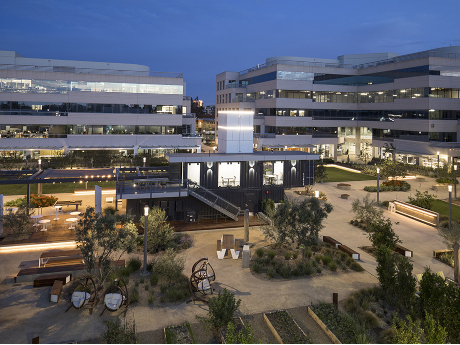— Scott Wetzel, Executive Vice President, JLL —
Tenants and debt remain the most important drivers of the Orange County office ecosystem — both having undergone major evolutions in recent history. Maybe unexpectedly, leasing velocity improved year over year, despite the never-ending drumbeat of a pending recession. Conversely, investment markets were much more cautious as debt cost spiked and investors pumped the brakes.
Leasing
From Bob Iger to Howard Schultz, prominent executives are voicing frustration over the state of the office market…and rightfully so. We watched the pendulum swing from end to end as office tenants went from fully “in office” pre-pandemic, to 100 percent remote for the better part of 2020 and 2021. Today, the national office usage rate still hovers around 50 percent, according to the most recent Kastle Systems report. Orange County reflects this national trend, meaning it’s stuck in the middle between in-office and in-home.
Tenants are also on divergent paths as some seek quality, while others prioritize value. New Orange County office developments like Flight (Lincoln Property Company), Boardwalk (AEW) and Spectrum Terrace (the Irvine Company) are fully leased and have achieved premium rental rates, typically 70 percent-plus above average market lease rates.
Large contiguous blocks of space in the market (i.e. greater than 50,000 square feet) are increasingly hard to find in new or recently renovated trophy office buildings that are well-amenitized. That said, a quick survey of high-rise offices would yield nearly 40 options. Tenants in Orange County have been very clear: they are optimizing their footprint and spending more money on high-quality assets, or they are bargain hunting for low-cost, low-rise alternatives as they work to get through whatever turbulence lies ahead.
The national headlines about tech layoffs have certainly hit the Orange Count marketplace, but in a much more muted way. Sublease availability is up nearly 30 percent year over year, but that’s spread across the market’s prominent business sectors, including tech, healthcare, consumer products and financial services. This is a much more even distribution compared to the outsized impact mortgage companies had on the Orange County office market during the Great Financial Recession.
Investment
The number of investment sales in Orange County held steady year over year, underscoring the 34 percent decrease in total volume dollar that came largely from a decrease in values. As interest rates quickly increased over the course of the year, investors were forced to recalibrate pro-formas. A highlight in Orange County was Intersect, the former Washington Mutual headquarters. Hines revamped this space as a creative office campus, then sold it to a foreign pension fund for more than $500 per square foot. While the number of properties on the CMBS default watchlist increases, investment sales may uptick in 2023, but it will be more out of necessity than desire. Until interest rates stabilize, office investment will remain tepid.
Development
In the wake of cost-prohibitive debt, only those who can live without it are willing to build. Enter the Irvine Company. Spec development projects like Phase II of Flight and the Village at Laguna Hills have been shelved. And without pre-lease commitments, even the Irvine Company will proceed cautiously. That said, it continues to move forward with Innovation Office Park, which has become of a hub of tech and life sciences activity. The firm is also considering a 550,000-square-foot life sciences development near UC Irvine. Almost ironically, the very product tenants are seeking most is the same kind lenders are hesitant to provide to eager developers. Nevertheless, hope springs eternal as interest rates settle, so the second half of 2023 will prove to be a busy one.



